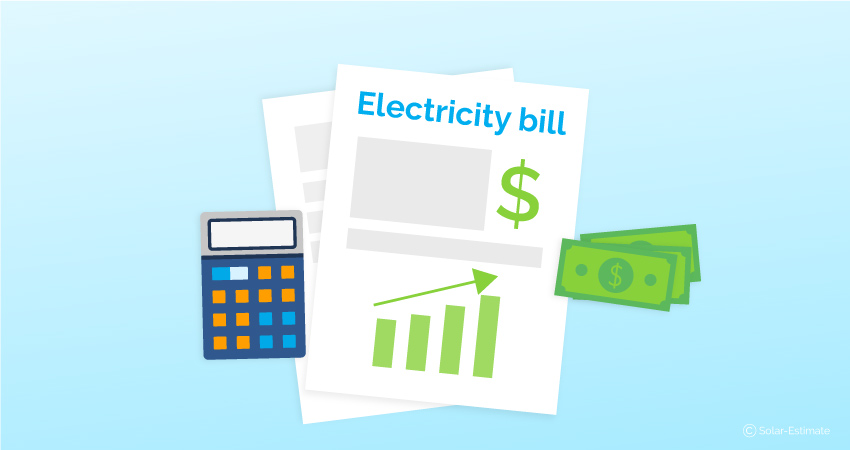Understand your power bill...and save money on it
Written by Andrew Sendy
Updated April 02, 2020
10 minutes read
Categories: Net metering, Solar 101, Solar efficiency, Solar energy, Solar incentives, Solar panels, Solar power

Reading your power bill can be a surprisingly difficult task. They are full of numbers and abbreviations that are hard to decipher. Luckily, you only need to understand a few key terms and know some basic math to get a grip on reading your electric bill. This article will help you achieve just that.
How is an electric bill calculated?
An electric bill usually consists of a rate, which is multiplied by the amount of power you use in kilowatt hours (kWh), along with a small service fee for supplying the electricity. If you’re on what’s called a time-of-use (TOU) plan, the rate will vary depending on the time of day you use your power.
Below is an example of how a basic utility bill is calculated:
|
Service Fee |
$10 |
|
Rate |
$0.12 /kWh (US average) |
|
kWh used |
1,000 kWh |
|
Energy charges |
1000 x $0.12 = $120 |
|
Total charge |
$120 + $10 = $130 |
What determines electric rates?
Your electric rate is the total of several different components, the break-up of which is sometimes displayed on the bill. The biggest two are the supply charge and the distribution charge, which typically make up most of the bill. The supply charge (sometimes called a generation charge) is how much it costs your utility to source or produce the power. The distribution charge is the cost to transmit it to you, the end customer.
Why is my electric bill so high?
Your electric bill could be high for a number of reasons. One common reason is that you live in an area with expensive power rates. Another is that your household uses a lot of energy. Often, both of these factors are involved.
Then there’s the issue of overall energy trends. The average home energy bill has been increasing steadily for the last 10 years — and rates are only set to rise.
How much am I paying for electricity?
The rate you pay for electricity should be one of the listed fields on your electric bill. It is the price of each unit, or kWh, of electricity you consume from the grid.
How can I save money on my power bill?
There are three main ways people reduce their energy bills:
- Use less power: While using less power will reduce your electric bills it can impact on your comfort. No one wants to sit in a hot living room in summer or be cold during the winter. However, there are some relatively easy change you can make, such as hanging your clothes out instead of using the dryer, or remembering to turn off the lights in rooms you aren’t using. Conserving energy is great — you help the environment while saving money — unfortunately in most cases it’ll only reduce your electric bill slightly.
- Install energy efficient appliances: Although these appliances can be expensive, many utilities offer rebates on air conditioners, programmable thermostats, hot water heaters and other home appliances. The Department of Energy has lots of helpful information of how to do an energy audit of your home and save money.
- Install a renewable energy system, such as solar panels: The best option to cut your power bills is to install a solar system. Most homeowners who go solar wipe out most, or even all, of their energy spend. A combination of great incentives and price reductions has created a booming residential solar industry.
How does solar reduce my average electric bill?
The biggest reason solar power saves homeowners a fortune in energy costs is a program called net metering. What net metering does is it makes your utility pay you for the excess solar generation your solar system sends them. Most solar systems during the day actually produce too much energy for your home; under net metering, you can sell it to the grid. The rate your utility pays you normally matches the rate you buy power at.
What solar incentives are available near me?
All Americans can benefit from the federal solar tax credit. States and municipalities offer additional incentives, but these vary depending on your location. To see the price of solar near you with local incentives enter your zip code below for a free estimate.
How much is the federal solar tax credit?
Through until the end of 2020, you can claim a full 26% of your solar system’s cost as a deduction to your federal income taxes. Pretty sweet, right?
How much does solar power cost?
Assuming an average 6 kW system, your solar panel cost will cost anywhere from $13,800–$19,800. The price you get depends on your location and installer. While that is a lot of money, the federal tax credit takes away 26% of that.
The final price of your solar system should be between $10,200–$14,650. Although this is a large initial investment, it is more than worth it: solar systems can save homeowners upwards of $100,000 in avoided electricity costs over 25 years.
How long will my solar system take to pay for itself?
In many states, this can be as short as 4-5 years. But solar payback times can vary greatly based on incentives, both state-level and utility, as well as the rates charged by your utility. To find your solar repayment with local incentives enter your zip code below.
